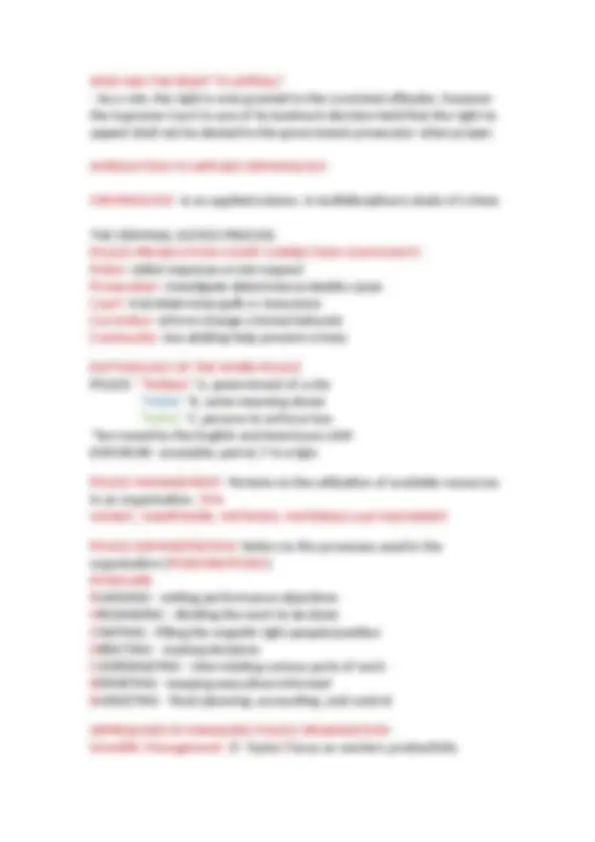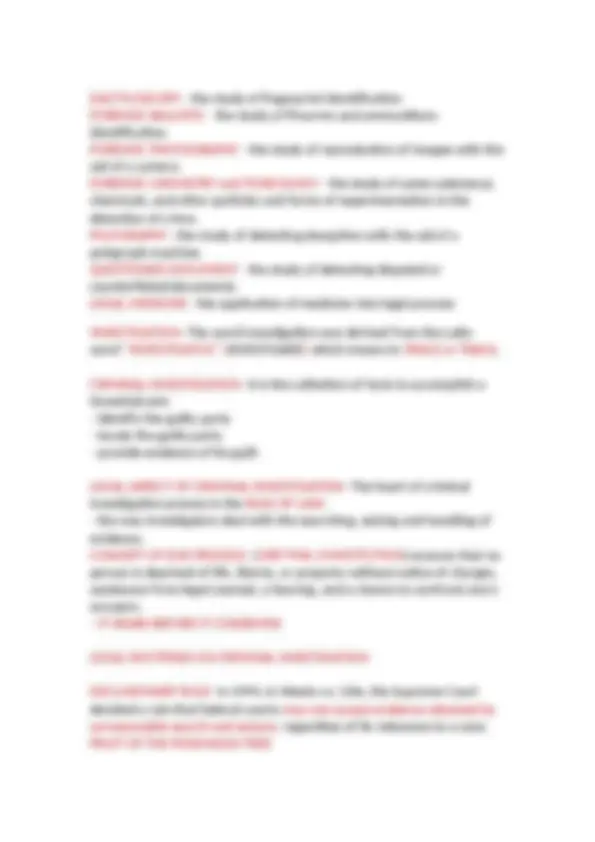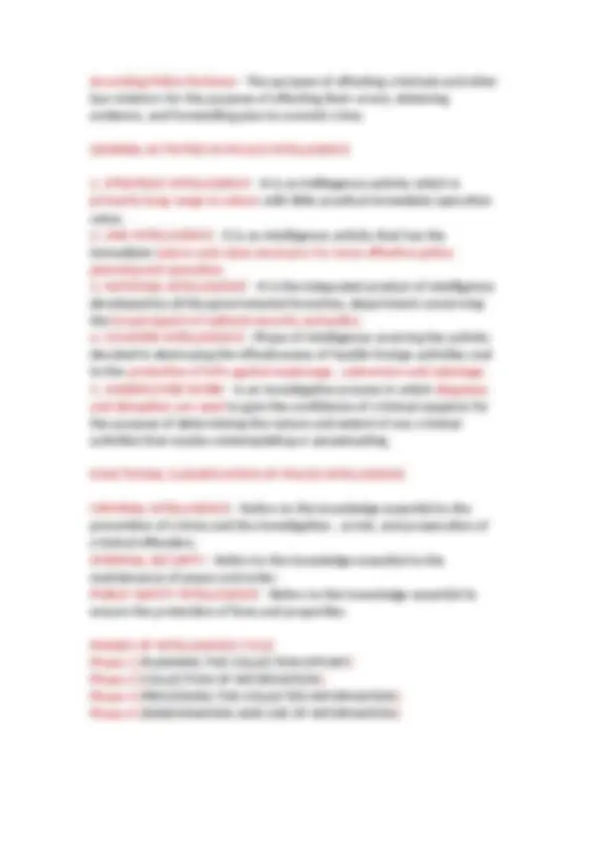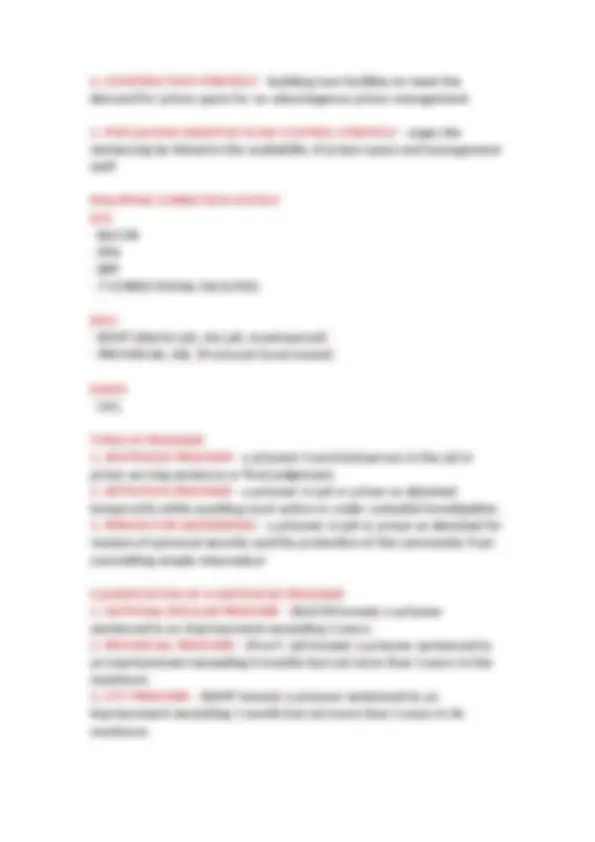











Study with the several resources on Docsity

Earn points by helping other students or get them with a premium plan


Prepare for your exams
Study with the several resources on Docsity

Earn points to download
Earn points by helping other students or get them with a premium plan
Community
Ask the community for help and clear up your study doubts
Discover the best universities in your country according to Docsity users
Free resources
Download our free guides on studying techniques, anxiety management strategies, and thesis advice from Docsity tutors
the contect is about the father of criminology and type of classical crimes
Typology: Summaries
1 / 15

This page cannot be seen from the preview
Don't miss anything!










ND PILLAR OF THE CRIMINAL JUSTICE SYSTEM PROSECUTION
Bureaucratic Management- (M.Weber) focus on division of labor and hierarchy of authority Administrative Mgmt- (H. Fayol) the 14 management principles
MIRANDA v ARIZONA - (1966) The Court ruled that all citizens must be informed of their rights prior to questioning. ‘’MIRANDA RIGHTS’’ THE FORENSIC SCIENCE SPECIALTIES PATHOLOGY - is a specially area of medicine. A study of diseases and the bodily changes caused by the diseases. FORENSIC PATHOLOGISTS - determine the cause of death/ determine the manner of death ENTOMOLOGY - a branch of insects FORENSIC ENTOMOLOGISTS - use insects as investigative aids, by examining insects, larvae or pupae ODONTOLOGY - is the study of the physiology, anatomy, and pathology of teeth FORENSIC ODONTOLOGIST - perform two types of analysis involving the human dentition. Pre-mortem and X-rays/ Bite marks comparison FORENSIC ANTHROPOLOGY - Physical Anthropology is the science of the human skeleton and how it has evolved over time FORENSIC TOXICOLOGY - is the study of the effects of extraneous materials such as poisons and drugs in the body FORENSIC PSYCHIATRY - is a branch of medicine concerning the diagnosis, treatment, and prevention of mental illness while PSYCHOLOGY is the scientific study of the mind and behavior of humans. FORENSIC ENGINEERING - involved in the investigation of transportation related accidents, materials failures, and structure failures FORENSIC COMPUTER SCIENCE - use information located on computers and other electronic devices as investigative aids CRIMINALISTICS - this specialty involves the examination, identification, and interpretation of items of physical evidence. BRANCHES OF CRIMINALISTIC
DACTYLOSCOPY - the study of fingerprint identification FORENSIC BALLISTIC - the study of firearms and ammunitions identification. FORENSIC PHOTOGRAPHY - the study of reproduction of images with the aid of a camera. FORENSIC CHEMISTRY and TOXICOLOGY - the study of some substance, chemicals, and other particles and forms of experimentation in the detection of crime. POLYGRAPHY - the study of detecting deception with the aid of a polygraph machine. QUESTIONED DOCUMENT - the study of detecting disputed or counterfieted documents. LEGAL MEDICINE - the application of medicine into legal process INVESTIGATION- The word investigation was derived from the Latin word ‘’INVESTIGATUS’’ (INVESTIGARE) which means to TRACE or TRACK. CRIMINAL INVESTIGATION- It is the collection of facts to accomplish a threefold aim:
According Police Parlance - The purpose of affecting criminals and other law violators for the purpose of affecting their arrest, obtaining evidence, and forestalling plan to commit crime. GENERAL ACTIVITIES IN POLICE INTELLIGENCE
NATURE OF INFORMATION - Information refers to all evaluated materials of every description including those derived from observation, reports, rumors, imagery, and other sources from which intelligence in produced. TWO GENERAL CLASSIFICATIONS OF SOURCES OF INFORMATION OPEN SOURCES - 99% of the information collected are coming from sources. CLOSE SOURCES - 1% of information are collected from close sources. TYPES OF INFORMANT CRIMINAL INFORMANT - an informant who give information to the police pertaining to the underworld about organized criminals with the understanding that his identity will be protected. CONFIDENTIAL INFORMANT - is similar to the former but he gives information violations of the law to include crimes and criminals. VOLUNTARY INFORMANT - a type of informant who give information freely and willfully as a witness to a certain act. SPECIAL INFORMANT - those who gives information concerning specialized cases only and it is regarded a special treatment by the operatives (ex. teachers, businessmen) ANONYMOUS INFORMANT - those who gives information through telephone with the hope that the informant can not be identified. MOTIVES OF INFORMANT